Kindred Kingdoms
Fiction
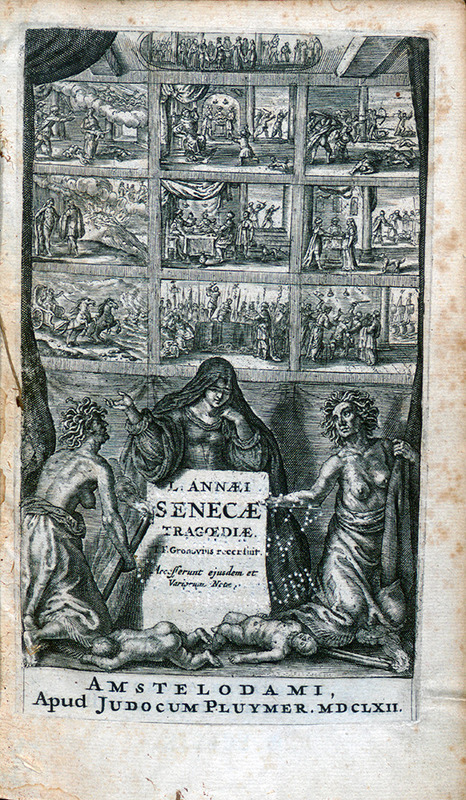
Seneca (Roman, ca. 4 bc-ad 65)
L. Annæi Senecae Tragoedia I. F. Gronovius recensuit: accesserunt ejusdem et variorum notæ.
Amstelodami: Apud Judocum Pluymer, 1662.
Special Collections & Rare Books
MU Libraries
Rare PA6664.A2 1662
More than Kin and Less than Kind
Hamlet Act 1, scene 2, 64-67
"I think that we humans are the animals that are in more need of saving than other animals. No other species is as committed to a path of such self-destruction (taking many other species down with it) as we are."
Lee Spark Jones, Kinship with Animals, 2004
The books in this case illustrate some of the most intricate, tortuous, and horrific (but sometimes amusing) relations among kin. Here, in a display of the classical authors of high tragedy, we begin with Seneca's Thyestes. Thyestes seduced his brother's wife and stole his golden fleece, the emblem of kingdom's prosperity. In turn his brother Atreus killed his two sons and served them as a dinner to their father. Later Thyestes raped his own daughter Pelopia, who gave birth to Aegisthus, the future murderer of his cousin Agamemnon.
Moving down the chronological line of one branching-out, hair-raising myth, we continue with Aeschylus's Oresteia: Orestes, son of Agamemnon and Clytemnestra, avenges his father's death by killing his mother Clytemnestra and her lover Aegisthus. His own sister Electra, who saved his life when he was a boy, was an accomplice in this murder. We follow with the hilarious Lysistrata by Aristophanes; and conclude with the giants of later epochs: Shakespeare, Tolstoy, Dostoyevsky, Wilde, and Thomas Mann.
To complement the theme of complex kinship interlacements, we put on display several books on humans turning into animals and vice versa (as in werewolf = wer [man in Anglo-Saxon] + wulf, wolf). You'll find here traditional tales such as Beauty and the Beast; modern masterpieces including H.G. Wells's The Island of Doctor Moreau (1896), Kafka's Metamorphosis (1915), and Mikhail Bulgakov's Heart of a Dog (1925).
In classical mythology, transforming mortals not only into animals but also into plants is common. We remember that Krokus, Narcissus, and Hyacinth were mortal men turned by the gods into flowers. Thus Ovid's Metamorphoses, a beautiful sixteenth-century manuscript of the famous first-century poem, illustrates this type of transformation.
Gallery
Click on the images below for more information.
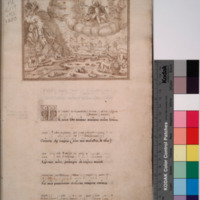
Ovid (Roman, 43 bc-17 or 18 ad)
P. Ovidii Nasonis Metamorphoseon.
Manuscript, ca. 1550.
Special Collections & Rare Books
MU Libraries
Rare Vault PA6519 .M2 1550
Metamorphoses (Transformations) is a poem by Ovid written in 8 A.D. and describing the history of the world from its creation to Julius Caesar' deification. It presents Greek gods and heroes in their frequent transformations into plants and animals, e.g. Europe abducted by Zeus who turned himself into a bull; the nymph Daphne, chased by Apollo and transformed into a laurel; or a proud weaver Arachne who challenged Athena, and was changed by the goddess into a spider.
The manuscript is written in rounded humanistic script on paper. There is no title page, but each of the fifteen books has a half-title illustrated with pen drawings.
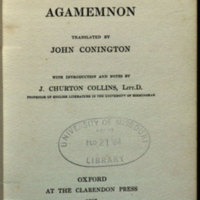
Aeschylus (Greek, ca. 525/524 B.C.-ca. 456/455 B.C.)
Agamemnon.
Translated by John Conington, with introduction and notes by J. Churton Collins.
Oxford : Clarendon Press, 1907
Special Collections & Rare Books
MU Libraries
J.G. Neihardt Collection
PA3827.A8 C6
Aeschylus, one of the greatest Greek tragedians, belonged to an old, noble and wealthy family fought as a warrior in several very important battles, including the Battle of Marathon where his brother died heroically. His trilogy Oresteia is the only complete trilogy that has come to us from antiquity. Agamemnon is the first of three plays; it was originally performed in 458 B.C. in Athens.
Atreus' sons Menelaus and Agamemnon married two sisters, respectively Helen and Clytemnestra. Helen was abducted by Paris of Troy, which ignited a war of Homeric proportions. Upon returning from the war, Agamemnon is murdered by his wife and his cousin Aegisthus, son of Thyestes and Clytemnestra's lover.
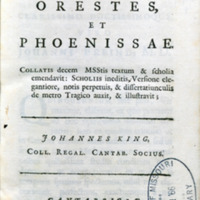
Euripides (Greek, ca. 480-408 bc)
Euripidis Hecuba, Orestes, et Phoenissae.
Cantabrigiae : Typis Academicis, 1726
Special Collections & Rare Books
MU Libraries
Rare PA3973.A3 1726
According to legend, Euripides was born on a day of Greek victory at Salamis in 480 B.C., where Aeschylus fought as a soldier.
He was twice married, unhappily both times, which some say was the reason for his misogyny. His play Orestes was first performed apparently in 408 B.C. The play opens with the Assembly of Argos that has to decide the fate of Orestes and Electra after they killed their mother Clytemnestra and her lover Aegisthus, thus avenging the death of their slain father Agamemnon. According to Richard Jebb, "the plot proceeds clearly to the point when Orestes and Electra have been condemned to death. But the later portion of the play with the final achievement of their deliverance is too inconsistent for a really tragic effect." However, the critic says that the play was popular, perhaps owning to the combination of striking sentiment with effective situation.
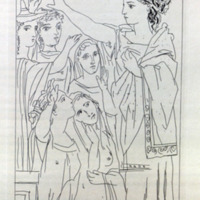
Aristophanes (Greek, ca. 446-ca. 386 bc)
Lysistrata.
A new version by Gilbert Seldes; with a special introduction by Mr. Seldes; and illustrations by Pablo Picasso.
New York: The Limited Editions Club, 1934
Special Collections & Rare Books
MU Libraries
Rare PA3877.L8 1934
Aristophanes was a great comic poet and dramatist. Forty-four comedies are ascribed to him, though only eleven have survived.
Lysistrata is a merry and frivolous play about women's struggle for peace. Lysistrata, an Athenian, called on women of Athens and Sparta to deny conjugal favors to their husbands and lovers in anti-war protest as a means of forcing the men to negotiate peace. It was first performed in Athens in 411 B.C. Lysistrata is one of a few classical comedies that are still on stage in modern theaters.
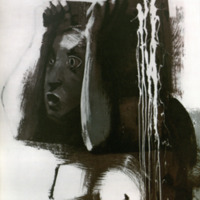
Aeschylus (Greek, ca. 525/524 B.C.-ca. 456/455 B.C.)
The Libation Bearers, from The Oresteia.
Translated from the Greek by E. D. A. Morshead. With an introduction by Rex Warner. Illustrated by Michael Ayrton.
New York, Printed by A. Colish for the members of the Limited Editions Club, 1961.
Special Collections & Rare Books
MU Libraries
Rare PA3827.A7 M7 1961
Orestes, the son of slain Agamemnon, with his sister Electra avenged their father's death by murdering their mother Clytemnestra and her lover Aegisthus.
The Libation Bearers is the second play of the Oresteia.

Aucassin & Nicolette, and Other Mediaeval Romances and Legends.
Translated from the French by Eugene Mason.
London, J. M. Dent; New York, E. P. Dutton, 1973.
Ellis Library
MU Libraries
PQ1302.E5 M3 1973
A beautiful medieval romance in the form of a chante-fable written in the Picardian dialect by an unknown author. The story is about two lovers, Aucassin, son of the lord of Beaucaire, and Nicolette, a Saracen girl who was brought to Beaucaire as a war trophy. The lovers overcome all obstacles put up by Aucassin's parents and after many hardships are happily reunited. There are some comical scenes of a pregnant King and a warrior Queen, of a war fought by weapons made of cheese and apples, and of Nicolette who had to dress up as a troubadour when she was in search of her beloved.
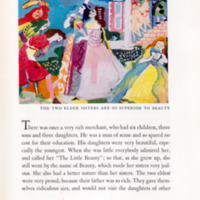
Madame Jeanne-Marie Leprince de Beaumont (French, 1711-1780)
Beauty and the Beast.
Translated from the French by P.H. Muir and illustrated by Edy Legrand.
New York : Limited Editions Club, 1949.
Special Collections & Rare Books
MU Libraries
Rare PZ8 .E94 1949 4
Jeanne-Marie Le Prince de Beaumont (1711-1780) was one of the popular eighteenth century French women writers. Just as her better known colleague, M-me de Genlis, she was governess for children in the households of the nobility. She advocated education of women, especially the study of Latin, which was quite unusual at the time. While her pedagogical principles were inspired by Locke and Rousseau, she was a devout Christian. Her La Belle et la Bête is the most known of her writings. She adapted it, shortened and revised considerably, from a book by Gabrielle de Villeneuve. It can be assumed that the plot was inspired by "Cupid and Psyche" in Apuleus's Golden Ass, or, perhaps, by the various Animal Bridegroom legends of folklore, such as the Russian Princess Frog, Swedish East of the Sun, West of the Moon, etc. In the story, the Beauty's destiny lies in the hands of her father, who gives her over to the Beast to save his own life. The Beast is a monster who eventually transforms into a human by the Beauty's love, courage and fidelity. But the Beauty is also transformed by learning to see beyond appearance — to recognize a prince in a beast.
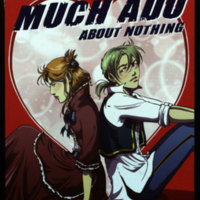
Richard Appignanesi
Much ado about nothing, adapted [from Shakespeare} by Richard Appignanesi
Illustrated by Emma Vieceli
New York: Amulet Books, 2009
Special Collections & Rare Books
MU Libraries
Comic In Process
A comic book version of Shakespeare's comedy about mistaken identities, eavesdropping and love. Benedick and Beatrice are tricked into confessing their love for each other, and Claudio is tricked into rejecting Hero at the altar. However, Friar Francis, a priest, and Dogberry, a constable, discover the evil trickery of the villain, Don John. In the end, Don John runs away, and everyone else joins in a dance celebrating the marriages of the two couples. This book is a new and experimental way to bring an eternal Shakespeare's text to students.
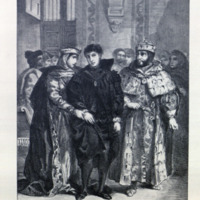
William Shakespeare (English, 1564-1616)
Hamlet Prinz von Daenemark.
[Textrevision von Max J. Wolff]; Mit 16 Lichtdrucktafeln nach den Lithographieen von Eugene Delacroix.
Leipzig: Inselverlag, 1913.
Special Collections & Rare Books
MU Libraries
Rare PR2782.H3 W6
Hamlet, prince of Denmark, returns from Wittenberg to attend the wedding of his mother to his uncle Claudius. When the ghost reveals that Claudius killed the king, Hamlet's father, to take the crown and the widow, Hamlet vows to avenge his father's murder. The rest is well known. This is the story of betrayal, love, duty and revenge.
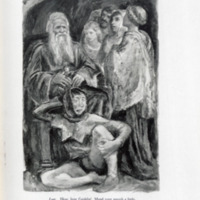
William Shakespeare (English, 1564-1616)
King Lear.
Edited and amended where obscure by Herbert Farjeon; illustrated from drawings by Boardman Robinson.
New York : Limited Editions Club, 1939
Special Collections & Rare Books
MU Libraries
Rare PR2819 .A1 1939
One of the most powerful plays by Shakespeare, written between 1603 and 1606. The poet tells us a tragic story of greed, flattery, betrayal, lust and father-daughters relations.
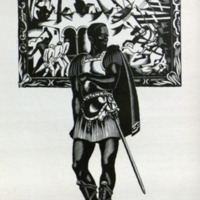
William Shakespeare (English, 1564-1616)
Othello.
Edited and amended where obscure by Herbert Farjeon; illustrated with wood engravings by Robert Gibbings.
New York : Limited Editions Club, 1939
Special Collections & Rare Books
MU Libraries
Rare PR2829 .A1 1939
Othello, a moor and a general in the service of the Venetian state, secretly marries Desdemona, daughter of the Venetian senator. He promotes Cassio, a young Florentine, to the rank of a lieutenant. An older soldier, envious Iago, plots his revenge. He instills the jealousy of Cassio into Othello's mind, who is driven to murder his wife by strangling her. Shortly thereafter, Iago's wickedness is discovered, and Othello kills himself in remorse.
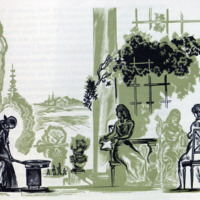
Leo Tolstoy (Russian, 1828-1910)
Anna Karenina.
Translated by Constance Garnett, edited by Bernard Guilbert Guerney and Gustavus Spett; with an introduction by Anatole Lunacharsky, and with wood-engravings by Nikolas Piskariov.
Moscow, U.S.S.R.: Published by the State Publishing House for Fiction and Poetry, 1933.
Special Collections & Rare Books
MU Libraries
Rare PG3366.A6 G3 1933
Happy families are all alike; every unhappy family is unhappy in its own way.
One of the most quotable lines in world literature, this opening of Anna Karenina defines the main ideological vector of the great novel by Leo Tolstoy, who explores the themes of adultery and fidelity, familial misery and happiness, passion, marriage, pregnancy, sports, homosexuality, use of contraception and narcotics, and, above all, of mortality and faith. The story of three families interlaced by matrimonial relations is given against the incomparably splendid background of the life of the Russian educated strata.
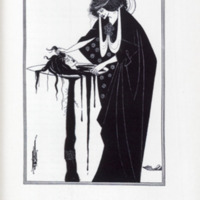
Oscar Wilde (Irish, 1854-1900)
Salome: A Tragedy in One Act.
Translated from the French of Oscar Wilde by Alfred Douglas and illustrated by Aubrey Beardsley; with a new introduction by Holbrook Jackson.
London, Printed for the members of the Limited Editions Club, 1938.
Special Collections & Rare Books
MU Libraries
Rare Folio PR5820 .S15 1938b
The Gospels (Matthew 14:3-11 and Mark 6:17-29) tell of the beheading of St. John the Baptist on the order of king Herod Antipas and the horrific role played in it by the daughter of Herodiade, Herod's incestuous wife.
In Oscar Wilde's play, the Judean princess Salome dances at the birthday party for her step-father Herod, and when the drunken king, charmed, offers her anything as a reward, she asks for the head of St. John the Baptist, whom Herodiade hates because he condemned her illicit marriage to her brother-in-law. Herod is afraid to harm St. John, knowing that he is a holy man and a prophet. Nevertheless, he follows up on his promise given in the presence of his guests and orders the murder. When St. John's head is brought in on a silver plate, Herod, repulsed by the way Salome kisses the severed head, orders to kill her. Oscar Wilde shows here deep corruption and wickedness that is concealed under the thin veneer of innocence.
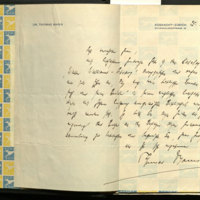
Thomas Mann (German, 1875-1955)
Joseph and His Brothers.
Translated from the German for the first time by H.T. Lowe-Porter.
New York : Knopf, 1934.
Special Collections & Rare Books
MU Libraries
Rare PZ3.M3184 Jo
This enormous novel was written mainly during Mann's émigré years in California (1933-1943), perhaps in an attempt to reconcile his own exile with the Biblical one. Mann retells the story from the Book of Genesis, exploring the themes of brotherly relations — Jacob's fear of his brother Esau paralleled with the bitter jealousy of Joseph by his older brothers. It depicts how Joseph was sold into slavery in Egypt and became the most powerful man in the land after the Pharaoh. The novel follows, and develops, the familiar lines of the reunification of the family in Egypt, the death of his father Jacob, and his mysterious blessing of Joseph's brothers and the two sons. This is a seminal story of betrayal, forgiveness, anxiety over a lost child, a happy reunion and unfathomable prophecy.
The book is with enclosed autograph letter from Thomas Mann to our library.
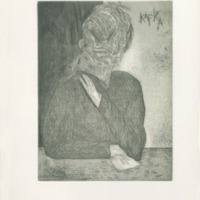
Franz Kafka (Austrian, 1883-1924)
Metamorphosis.
Translated by Willa and Edwin Muir; with drawings & etchings by José Luis Cuevas; introduced by Robert Coles.
New York City: The Limited Editions Club, 1984.
Special Collections & Rare Books
MU Libraries
Rare PT2621.A26 V413 1984
Franz Kafka, a modest insurance agent from Prague, was one of the greatest novelists of our time. His hero, Gregor Samsa, a traveling salesman, one morning discovers himself transformed into a giant insect. This obviously changes his life most radically. His family used to live on his earnings, but they all turn against him. His sister, the most compassionate of all, initially cares for him but later feels repulsion; his father, who has to take a job, pelts him with apples (one of which gets stuck between his wings and rots there). Even his mother cannot overcome her disgust. Finally the family decides to get rid of him. Weakened and sick, he starves to death. His kin joyfully look forward to life without Gregor.